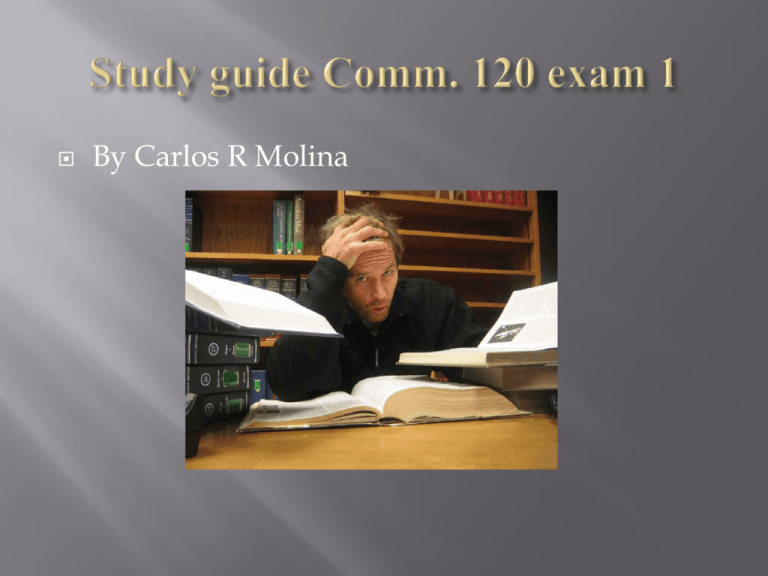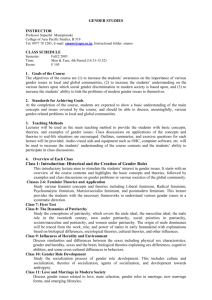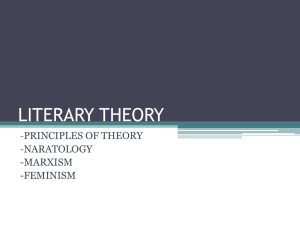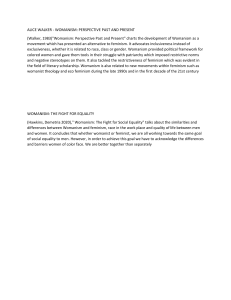
By Carlos R Molina
Feminism is not one single position. Wood defines it
as “an active commitment to equality and respect for
all forms of life’ p4. “Being “against oppression, be
it the oppression of women, men, people with
disabilities, specific sexual identities, particular
race-ethnicities elderly people, children, animals, or
our planet” p4
Sex: is a designation based on biology.
Gender: is a socially constructed and expressed.
It is learned and it changes. There are not 2
distinct genders.
(biology influences how we develop but it does not
absolutely determine behavior and personality.)
Definition of culture: Culture refers to
“structures…and practices that uphold a
particular social order” p31
(our culture
directly influences how we feel about gender.)
Communication: is a dynamic process; is
systemic (occurs within particular situation or
situations); has 2 levels of meaning: content
(literal) and relationship.
Biological Theories of gender: these types of
theories offer on explanation for differences
between women and men: biological
characteristics. These theories say that
differences between men and women are based
on differences in chromosomes, hormones, and
brain structure.
Interpersonal theories of gender: These types of
theories assume that interpersonal factors
influence the development of femininity and
masculinity.
Psychodynamic Theories: the first relationship
an infant has fundamentally influences how an
infant comes to define his/her identity.
Social learning: individuals learn how to
masculine and feminine by imitation of other and
getting positive or negative responses from others
to their behaviors.
Cognitive development: assumes children play
active roles in developing their gender identities.
Children pick models to teach them competency.
Symbolic Interactions: We learn who we are
through communication.
•
Standpoint theory: membership in groups shape
what individuals experience, know, feel and do.
This theory claims that marginalized groups can
generate unique insights into how a society
works.
Queer performative theory: argues that identities are
not fixed. Argues that humans generate identities
through performance (expression).
Liberal Feminism: women and men are alike and
equal in most respects.
Cultural Feminism: women and men are
fundamentally different and should have different
right.
Rhetorical Movement “A collective persuasive
effort to challenge and change existing attitudes,
laws and policies” p66
1840-1925
Included liberal and cultural feminist branches.
The women’s rights movements
1918-1920, nonviolent protesting for women’s
suffrage (Alice Paul, Lucy Burns)
August 26, 1920: women were
granted the right to vote.
The cult of Domesticity; believed women were
more moral, nurturing and concerned about
others than men. They believed in “true
womanhood” and focused on good homes,
families and communities.
•
Radical Feminism: Women’s liberation movement.
Basic principle was that oppression of women is the
fundamental form of oppression on which all others
are modeled.
Lesbian Feminism: They define themselves as
women identified to distinguish themselves from
heterosexual women whom they see as maleidentified.
Separatism: build communities in which women
live independently in mutual respect and
harmony.
Revalorism: focus on appreciating women’s
traditional activities and contributions and
increasing society’s appreciation of women and
there contribution to society.
EcoFeminism: 1974. As long as oppression is
culturally valued, it will be imposed on anyone
and anything that cannot or does not resist.
Radical, lesbian, separatism, revalorism and ecofeminism are all cultural feminist movements
because they share the idea that women and men are
different in important ways.
Liberal Feminism: identifies and challenges
institutional practices, policies, and laws that
exclude women form positions of influence in
public and professional life.
Womanism: Many African American women see
womanism as addressing both their racial and
gender identities.
Multiracial Feminism: insist that gender does not
have universal meaning instead, what gender
means and how it affects our lives varies as a
result of race, economic class, sexual orientation
and so forth.
Power Feminism: society doesn’t oppress
women, because women have the power to
control what happens to them.
This wave includes women of different ethnicities,
abilities and disabilities, classes, appearances and
sexual orientations. Recognizes that women differ
in many ways.
The 5 features of the third wave feminists
Remaking solidarity to incorporate differences
among women;
Building coalitions;
Integrating theory in to everyday practice;
Insisting that political is personal; and
Being media savvy.
*6. Embracing aesthetics and consumerism.
Profeminist Men’s Movements
A profeminist refers to a male feminist.
Profeminists believe men and women are alike in
most ways.
Profeminists support women’s battles for equal
treatment in society.
National Organization for Men against Sexism.
profeminist men’s movement
Condemns most conventional masculine qualities
such as aggression, violence and emotional
insensitivity.
Formed in ’91, it is now the largest men’s
antiviolence group in the word.
Masculinists, or promasculine men, believe men suffer
from discrimination because of their sex and that
men need to reclaim their manliness.
The main rhetorical strategy of masculinists is to
verbally disparage men who define themselves as
feminists or who believe that women are entitled to
the same rights as men.
Angry and hurt that men don’t have at least 50%
custody of their children after divorce. (fathers 4
justice, American Coalition for fathers, fathers and
Families, ect)
Want men to rediscover their roots of masculine
thinking and feeling.
Argue that the traditional masculine ideal was
positive.
Men need to reclaim courage and aggression.
View reconnection to God’s commandments as the
path.
Based on evangelical Christianity.
Value strong families and communities.
Most are white and middle- or upper class.
Occurred in Washington, DC on October 16,
1995
Movement for African American men to register to
vote, fight drugs, recommit themselves to their
children and families and stand against
unemployment and violence.
References
Dr. Niles study guide
Wood J. T. (2009) Gendered lives:
communication, gender, and culture (8th ed.)
Boston: Wadsworth Cengage Learning









